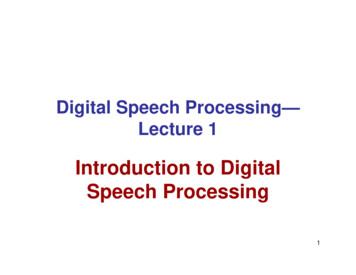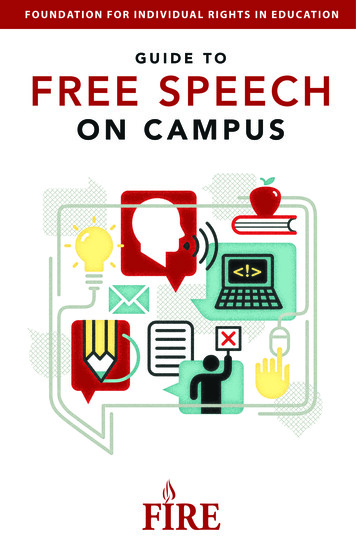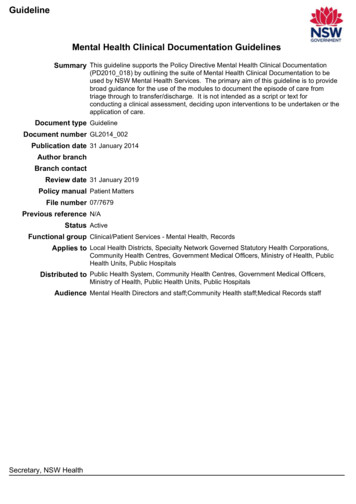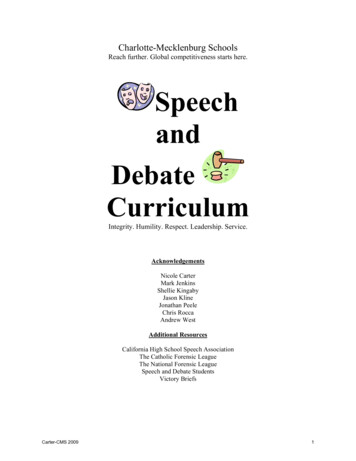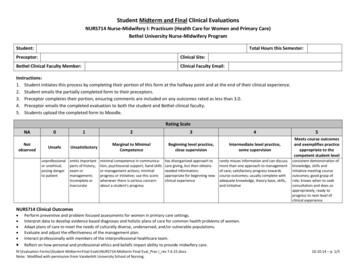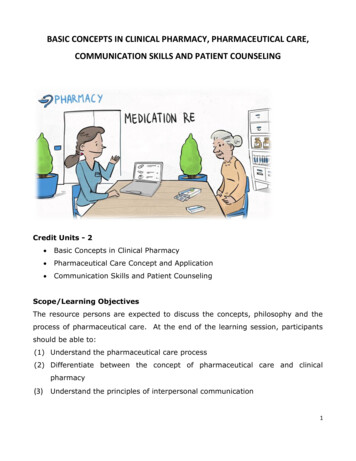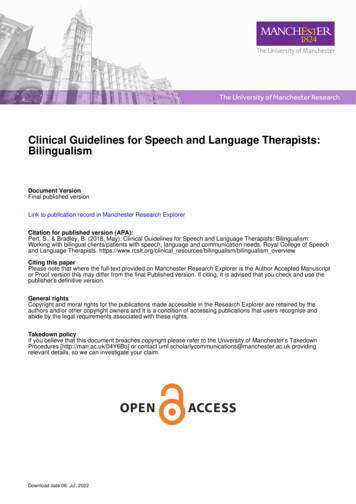
Transcription
The University of Manchester ResearchClinical Guidelines for Speech and Language Therapists:BilingualismDocument VersionFinal published versionLink to publication record in Manchester Research ExplorerCitation for published version (APA):Pert, S., & Bradley, B. (2018, May). Clinical Guidelines for Speech and Language Therapists: Bilingualism:Working with bilingual clients/patients with speech, language and communication needs. Royal College of Speechand Language Therapists. https://www.rcslt.org/clinical resources/bilingualism/bilingualism overviewCiting this paperPlease note that where the full-text provided on Manchester Research Explorer is the Author Accepted Manuscriptor Proof version this may differ from the final Published version. If citing, it is advised that you check and use thepublisher's definitive version.General rightsCopyright and moral rights for the publications made accessible in the Research Explorer are retained by theauthors and/or other copyright owners and it is a condition of accessing publications that users recognise andabide by the legal requirements associated with these rights.Takedown policyIf you believe that this document breaches copyright please refer to the University of Manchester’s TakedownProcedures [http://man.ac.uk/04Y6Bo] or contact uml.scholarlycommunications@manchester.ac.uk providingrelevant details, so we can investigate your claim.Download date:06. Jul. 2022
Bilingualism - GuidanceUnlike other clinical guidelines, which provide SLTs with guidance on specific clinicalpopulations, this document highlights the needs of bilingual clients and their families.Bilingualism is not a clinical disorder, but a typical human attribute, central to the bilingualperson’s identity. These guidelines may therefore apply to any clinical populationencountered by SLTs.Key Points The RCSLT is committed to supporting bilingual individuals and their families,recognising bilingualism as the norm. Bilingualism is an advantage in a person of any age. This is regardless of the specificcombination of languages and/or dialects spoken by the bilingual person. Bilingualism is an advantage regardless of the presence of a speech, language, orcommunication disorder, or feeding and swallowing difficulties. Bilingualism does not cause, or contribute to, a speech, language or communicationdisorder. Working with interpreters is a core skill for speech and language therapists, includingbilingual SLTs. Services should allocate at least double the time for bilingual clients and their familiesin order to achieve the same positive outcomes as monolingual clients, and thereforedeliver an equitable service.1
Table of contentsOverview . 3Main Learning Points . 4Terminology - Adults . 8Terminology - children and young people. 9Characteristics . 27Vulnerability and risk issues - adult . 28Vulnerability and risk issues - children . 29Staffing in bilingualism (all age groups) . 32Staffing in bilingualism - adults . 32Staffing in bilingualism - children . 34Interpreters . 36Education and training . 39Audit and service evaluation . 41Guidelines on assessment and management - adult clients/patients. 42Guidelines on assessment and management - Children . 45Cultural competence . 59Safeguarding, Child Protection and Vulnerable Adults in the Context of Bilingualism . 61Policy England . 62Policy Scotland . 62Policy Wales . 62Policy Northern Ireland. 63Policy UK . 632
Bilingualism - overviewAny person presenting with a speech, language, communication or feeding and swallowingdisorder may also be bilingual. This is because bilingual people are as likely to encounterthese difficulties as monolingual speakers (Winter, 2001:465; Stow and Dodd, 2003;Mennen, Stansfield and Johnston, 2005).Bilingualism does not cause or contribute to any of these difficulties. However, for a bilingualperson and their family, accessing services and their experience of services can be hinderedby well-meaning, but misinformed professionals. Many highly negative myths are associatedwith bilingualism, and these are still regularly encountered by bilingual communities.As evidence-based professionals, speech and language therapists are committed to relatingthe research on both typical bilingualism and bilingualism in the context of speech, languageand communication disorders to clinical practice. In combination with the informed views andbeliefs of the client, and our clinical experience (Sackett, Gray, Haynes & Richardson, 1996)it is possible to deliver effective and supportive care in a language one does not share withthe client.The key role of interpreters and bilingual staff makes this possible, and they should beconsidered valued members of the team. Despite long-standing professional guidelines,monolingual SLTs and other professionals are sometimes hesitant to work alongsideprofessional interpreters, or find this relationship challenging (Palfrey, 2013; Zendedel,Schouten, van Weert and van den Putte, 2016), with many ‘getting by’ in English (or othermainstream language) with the help of ad hoc interpreters such as friends, relatives andeven children in the family (Wu and Rawal, 2017).SLTs should ensure that professional interpreters are involved in all aspects of assessment,providing: advice, assessment, intervention, and multi-disciplinary meets and any decisionmaking in partnership with the client and family. Financial considerations of working withinterpreters are overridden by legal requirements to provide equitable services (Equality Act,2010; United Nations Convention on the Rights of the Child, Article 2)"A huge barrier to working with bilingual clients in the past was the availability of informationabout other languages, such as phonological inventories, descriptions of syntax, grammarand morphology and cultural knowledge.Much research has been directed into these areas and there are now data available onmany languages, including resources specifically for speech and language therapy inlanguages other than English. There is still much to do in this area, but the practitioner nolonger needs to work from a blank slate for most families encountered in the UK.Societal and individual attitudes to bilingualism are often crucial factors in clients andfamilies valuing their home language(s). Many bilingual communities are resident in the UK.Some communities have been established for many generations and are UK citizens, whileother communities are new arrivals in the UK.Politicians have often linked ethnicity with language use, reiterating the myth that speaking ahome language is a barrier to acquiring English. Speech and language therapists are wellplaced to advocate for home language use and explain the benefits, while debunking themyths. There is strong evidence that associating high status with home language promotesits use (King, Fogle and Logan-Terry, 2008).3
For some bilingual communities, the negativity and prejudice of the past has been replacedwith optimism and a new found high status. Welsh language use has grown, and Gaelic andWelsh medium schools are now desirable educational routes for many families.Speech and language therapists through their training have professional communicationskills at their highest levels. For instance SLTs have the skills required to support a personwith aphasia to recall words in English and home language following a stroke, toexplain thickening food and drink to a carer with an interpreter, or working on phonologywith a child in home language.Working in a language one does not share with the client can be challenging, but theoutcomes for the client and family are both clinically and professionally rewarding.Main Learning Points Bilingualism is an umbrella term, which includes the concept of multilingualism, andmulti-modal language use such as sign language. Collaborating with professional interpreters should not be viewed as optional, andmust not be restricted by budgetary constraints. The main aim of assessment is to differentiate diversity from disorder. Assessment and intervention must always be carried out in both/all languages. The main aim of intervention with bilingual clients is to maintain, restore or achievebilingualism. Professionals in the UK are committed to providing equitable services to allindividuals (Equality Act, 2010) and not to discriminate based on language (UnitedNations Convention on the Rights of the Child, Article 2) The World Health Organization International Classification of Functioning, Disabilityand Health (ICF, WHO, 2007) can be effectively used to aid the practitioner infactoring multilingualism into the clinical reasoning process. If there is a communication disorder, then it will be present in both/all the languagesthat the individual understands and uses. Speech and language therapists should never recommend abandoning the homelanguage(s) in favour of additional language learning. Services with a high level, i.e. 5-10% or more of bilingual people in the localpopulation, should consider developing a specialist bilingual service. Services should ensure that all staff working with bilingual clients/patients haveaccess to training on typical bilingualism and speech, language and communicationdisorders in the context of bilingualism.4
Bilingualism in the UKBilingualism and multiculturalism are common in the majority of countries around the worldand can be observed across all ages and societal status. The ongoing need to experiencenew interactions, education, job opportunities, immigration and relationships encourage theneed to communicate in other languages besides the mother tongue (referred to as ‘homelanguage’ in this guidance).The advantages that bilingualism offer may extend further than just a linguistic addition; it isthought by some researchers that bilingualism positively improves cognitive abilities aswell.“It is sometimes assumed that ‘English is enough’, but in global terms only 6% of thepopulation are native English speakers and 75% speak no English at all” (Multilingual Britainreport, British Academy and Cumberland Lodge, 2012).There are no reliable figures on the number of bilingual speakers living in the UK. Althoughthe National Census asked about language for the first time in 2011, respondents wereasked about their ‘main language’. Unsurprisingly, the overwhelming majority reported:English as their main language (92% or 49.8 million), and of the remaining eight percent (4.2million) who had a different main language, the majority (3.3 million) could speak Englishwell or very well. (Office for National Statistics, 2013).The question ‘hides’ the bilingual speakers who may use English for work and everydayactivities, but regularly use another home language or languages.Indigenous languages of the British Isles: English is the most widely spoken language of the United Kingdom with 92% (49.8million) speaking English as their main language, and of the remaining eight percent(4.2 million) who had a different main language, the majority (3.3 million) could speakEnglish well or very well. (Office for National Statistics, 2013). English is a high statuslanguage with English used for the internet, scientific journals, teaching, businessand popular culture, including films and popular music. English is the language inwhich most speech and language therapy degrees are taught in, and as a result, themajority of speech and language therapists are English speakers and until recently,assessments and therapy packages in languages other than English were rare.An estimated 700,000 people speak Welsh in the UK, the official language of Wales.Welsh is a language of mainly Celtic origin, although there are influences from Latin,French and English (Davies, 2014: 180).An estimated 1.5 million people speak Scots (i.e. Germanic language variety spokenin Lowland Scotland and part of Ulster) in the UK, which is a sister language ofEnglish.An estimated 15,000 people living in England and Wales, reported themselves usingBritish Sign Language as their main language.An estimated 73,804 native speakers in Ireland (2016) speak Irish also known asGaelic or the Irish Gaelic.An estimated 57,375 people in Scotland speak Scottish Gaelic which is classed as aindigenous language.Angloromani is spoken in the United Kingdom and refers to the use of Romani originwords within English conservation.An estimated 300-400 people in Cornwall speak Cornish, which is a SouthwesternBrittonic Celtic language. Cornish is currently recognised as a minority language inthe UK5
Shelta is a language spoken by Irish travellers. The exact number of speakers in theUK is hard to determine.Migration in the UKThe fast changing demographics in the United Kingdom is influenced by migration.According to the Office of National Statistics around 1 in 7 (14%) individuals were bornabroad, with Poland being the most common non-UK country of birth (an estimated 911,000residents) as of 2016.Likewise, the Migration Observatory at Oxford University (Feb 2017) reported that Poland,India and Pakistan are the main three foreign countries of birth. There are also about141, 000 Chinese speakers and other pockets of smaller groups.“Looking at the distribution of foreign-born by age, including children (those aged 0-15),youth (aged 15-25), adults (aged 26-64), and retired (aged 64 ), the vast majority of foreignborn people are adults (70.9%), while 9.4% are children, 9.9% are youth, and 11% areretired” (Vargas-Silva & Rienzo, 2017).This change in demographics creates a challenge for speech language therapists to meetthe needs of speakers of languages whose first language is not English in the delivery ofservices.Figure 1. Top Ten Languages in England and Wales, 2011 Census.6
It is noteworthy that the census highlighted that ‘Half (10,800) of those who reportedPakistani Pahari (with Mirpuri and Potwari) as their main language lived in Birmingham’.Pakistani heritage languages including Mirpuri, Punjabi and Urdu are thought to be the thirdmost widely spoken home languages after English and Welsh.These languages share a large proportion of lexical items but have different grammar (SeePert, 2007 and Stow, 2006 for an overview).These data and other surveys should be considered after considering the definition of‘language’, and ‘dialect’, as both terms may cause significant confusion and lead to errors oflanguage reporting and therefore the work of speech and language therapists when trying tomatch a family with a suitable interpreter, or when seeking information on a language.The National Association for Language Development in the Curriculum (NALDIC) publishinformation from the School Census in England. The 2012 census indicated that there are 18languages spoken by more than 10,000 pupils.This provided similar results to the census, but with Punjabi and Urdu being the mostpopular after 6%1.3%0.8%0.6%0.6%0.6%0.4%0.4%Table 1. School census January 2012 language data nationally and by local authorityStatistics for Schools in Scotland 2016 suggested 39,342 pupils as having EAL and that2011 census data suggests 150 languages other than English used across Scotland.The following guidelines provide information and guidance on working with bilingual clientsand their families. Bilingual clients can often be amongst our most vulnerable, and the loss ofhome language can have severe negative lasting effects on an individual. These guidelinesare designed to support, maintain and promote bilingualism, even when individuals havevery limited communication.Further reading Multilingual BritainOffice for National Statistics7
Terminology - AdultsDefinition of bilingual and bilingualismPeople are considered bilingual when they need to communicate in two or more languages.‘As language is a dynamic, complex social tool developed over extended time periods’(Kohnert, 2013, p. 17), bilingualism does not have a straightforward definition.There is substantial variability amongst bilingual and multilingual individuals as itincludes different levels of proficiency, competency and fluency which can vary over thelifespan of the individual.An adult can be bilingual from childhood or become bilingual by acquiring anotherlanguage(s) late in life due to social interests, working related activities, or migration.Grosjean (1982) has explained that with time, an adult can become as bilingual as a childbut an accent may be present, and this is not an indicator of proficiency or competency.The inhibition control model proposes (Kroll, Bobb & Misra, 2008) that neurotypical healthybilingual adults can speak either in L1 or L2, thus separating both languages if necessary.This is known as monolingual mode. It is important to note that the non-targeted languagein the monolingual mode is not completely deactivated (Kohnert, 2013). Both languagesremain active to a certain extent with no signs of interference.This indicates a healthy pattern of the neurotypical brain (and an advantage of beingbilingual) as it is successfully using cognitive resources to resist interference (Kohnert,2013). In a bilingual mode both languages are active and code switching appears moreregularly, if appropriate.With age, it is normal to present with increased interference and code switching between twoor more languages (Ardila & Ramos, 2008). An older adult may choose, or need, to use justone language despite having used two or more languages regularly in younger years.Adults who are sequential language learners will reflect in their acquired language (L2)skills differences which may be influenced by their first language system. It is important forthe speech and language therapist to consider this this matter and its impact whenassessing the adult.Other typical processes experienced by bilingual adults are:TerminologyKey ultural process that allows a person to move frommonoculturalism towards biculturalism. This is usually a processthat allows individuals from minority cultures to adopt traits of themajority culture.AdditiveBilingualismChildrenAdultsIs a process in which the acquisition of a second language doesnot occur at expense of maintenance and development of thenative language.8
AttritionNormalprocessChildrenAdultsLanguage loss, which is the decline in previously attainedlanguage ability and skills. L1 or L2 are susceptible toenvironmental opportunities.Note: Language shift occurs in language communities and SLTsshould be aware of any relevant research on the particularcommunity the individual is from, and the effects of languagecontact generally.AssimilationCultureAdultsCultural process that correlates with subtractive bilingualism asit is the loss of a person’s traditional/original culture.Cross LanguageGeneralisation(tag)AdultsInterventionAs both languages are active in a bilingual mode, then supportingone language will result in changes in all languagesCognitiveReserve (tag)AdultsAdvantageAbility the brain has to withstand and or resist neuropathologybefore cognitive function is affected. Bilingualism is thought to bea contributing factor to increase it.LanguageInterference (tag)AdultsChildrenNormalProcessIs the effect of language learners’ first language L1 on theirproduction of the second language L2. It means L1 influences L2.It can be positive if one language aids in developing skills for asecond language or negative effects if it hinders it.LanguageProficiency (tag)AdultsChildren‘refers to skill or ability in a particular linguistic code, with no apriori standard or benchmark. Proficiency is a noun that requiresa modifier to fully appreciate its meaning. High proficiency,native-like proficiency, or minimal proficiency can all be used todescribe the relative level of attainment in a particular language’(Kohnert, 2013: 21).PassiveLanguage SkillsAdultsChildrenRefers to the ability to have a good understanding of a languagewith very little ability to express using it.SubtractiveBilingualismAdultsChildrenIs the loss of the native language as a result of acquisition of thesecond language. Subtractive bilingualism often results inmonolingual proficiency in the majority language.Terminology - children and young peopleTypical bilingualismThe following sections provide an overview of typical bilingualism. This includes essentialinformation and terminology, which the reader needs to be familiar with prior to consideringspeech, language and communication disorders in a bilingual context.Definition of bilingual and bilingualismBilingualism is the ability to understand and/or use two or more languages. The termtherefore encompasses ‘multilingualism’, which is the knowledge and/or use of severallanguages.The languages in question may be spoken languages, sign languages, or a combination(Lillo-Martin, de Quadros, Pichler and Fieldsteel, 2014). To be bilingual an individual does9
not have to have equal fluency in both languages, or mastery of both languages. (Baker,2000, Meisel, 2004, Myers-Scotton, 2006, Romaine, 1995).A bilingual person may routinely use their languages in different contexts and for differentpurposes, such as home life and education or work. The bilingual person may therefore nothave the same communicative skills in both their languages (Rowland, 2013). Any individualwith knowledge of more than one language should be considered bilingual, regardless of therelative proficiency of the languages understood or used.Bilingualism is not a disorder and there is no evidence that bilingualism causes orcontributes to any speech, language or communication disorder (Hampton, et al, 2017)Language is core to a person’s identity and culture. The use of other languages should bevalued, respected and encouraged, as the impact of language loss on an individual orcommunity can have a serious negative impact on concepts of identity, self-respect, andheritage culture and these effects are often permanent.Bilingual people and communities are the majority in the world and bilingualism is the naturalstate of human beings (Mennen, Stansfield and Johnston, 2005). Bilingualism is oftenviewed with suspicion and negatively by majority language speakers, with unfoundedconcerns that exposure to more than one language may confuse or otherwise negativelyaffect the child’s development.Such misconceptions must be challenged with the extensive research evidence showing thatbilingualism is an advantage in children and adults (Wei, 2000).Home language, Mother Tongue, and Our languageTerminology for languages is problematic, as for simultaneous bilingual children there is noclear L1 and L2. Most children in the UK arrive at bilingualism by speaking one language athome and another for education (sequential bilingualism) and so L1 is the home languageand L2 is typically English, Welsh or Gaelic.‘Home language’ therefore reflects the typical scenario in the UK for minority ethnic families,who constitute the largest group of bilingual children. ‘Mother tongue’ is the term adopted bythe World Health Organisation which reflects the fact that mothers tend to be the primarycaregiver in a family, and hence provide the language input for infants. This has thedownside of excluding same-sex male couple, single parents who are male, or gender nonbinary, and adoptive single parents and other carers.Language, dialect and accentBoth the UK National Census and the Schools Census report languages which seem tomatch political borders (countries), or regions. Language reporting is fraught with complexity,making the statistician’s work more challenging. Language and identity are closely linked.This means that ideas of national and regional identity, and social status may affect thelanguage label reported by a particular speaker (Grosjean, 1982; Stow, 2006, Pert, 2007).The situation may become even more complex if there are several forms of the language.Each language has at least two variants, a standard or high status form and a non-standardor lower status form. The high status form is often associated with power and influence, andused by those in politics, the media and the wealthy.10
Consider English. The ‘Received Pronunciation’ or ‘BBC English’ form is considered to bethe ‘correct’ or ‘clearest’ form by many English language speakers, even if they do not usethat form themselves (Hughes, Trudgill and Watt, 2013).Other ‘accents’ or ‘dialects’ are often judged to be ‘incorrect’ or less desirable. Speakers ofthe non-standard form are often judged more negatively.A dialect is ‘.a language variety distinguished from other varieties by differences ofgrammar and vocabulary. Standard (British) English is therefore a dialect of English, just asthe other standard dialects of the language (Standard Scottish English, American English,etc.) are, and all non-standard dialects of the language too. Accent.refers just to variationsin pronunciation.’ (Hughes, Trudgill and Watt, 2013: 3).In the same way, different varieties of related languages are perceived as being associatedwith high or low social status speakers. In a review of speech and language therapyreferrals, Stow (2006) found that only 45% of bilingual children had their language correctlyidentified on the referral form. Parents often reported ‘Urdu’ (a high status language) forchildren speaking Mirpuri and Punjabi.Mirpuri, Punjabi and Urdu, were considered so different by the service that different bilingualco-workers were employed, and speakers reported that they were not mutually intelligible.The use of the term ‘dialect’ is therefore subjective and speech and language therapistsneed to consider that if ‘dialects’ are functionally different, then they should be treated asfunctionally separate languages.Different variants of a language may also have the same label which can confuse those whoare not aware of this, e.g 'Kiswahili', the higher status form spoken in Tanzania and Kenyan‘Kiswahili’ are different variants.MonolingualismMonolingualism is the use of only one language. This is the typical only for a minority ofhumans. However, monolingualism is mistakenly considered the ‘nature’ or ‘normal’ state ofhuman beings by speakers of high status monolingual communities. Early research intobilingualism considered bilingual language acquisition as a threat to the successfulacquisition of the majority language (typically English) .This misconception was reinforced by the focus on the majority language capability andignoring the person’s ability in their home language.Majority languageThis is the language spoken by most people in a community. This language often hasassociations of high status as it is the language of education, work, law, and the media. Forthis reason, the majority language is often viewed as essential and the only correct form ofcommunication.Other languages are often compared unfavourably with the majority language. In the UK,high status languages used in these contexts include English, Welsh and Gaelic.11
Minority languageIn contrast to the majority language, minority languages are spoken by a small number ofindividuals or communities. Minority languages are used by people who may or may not alsospeak the majority language.Minority languages may be seen majority language speakers as unhelpful, due to misguidedbeliefs that the use of a minority language is a barrier to speaking the majority language.The English language spoken in the UK represents a dominant cultural context, where onelanguage i.e. English is most widely used by the majority of the population. Many factorsimpact upon the acquisition of a heritage language in the context of a dominant languageenvironment.Within this context, a bilingual’s languages may be viewed as languages in contact, whichare often altered because the two languages influence each other. Studies have s
3 Bilingualism -overview Any person presenting with a speech, language, communication or feeding and swallowing disorder may also be bilingual. This is because bilingual people are as likely to encounter

